Creating content for SEO purposes is often associated with keyword-stuffed articles that lack quality and voice. But, as Google continues to push search marketers towards optimizing for humans instead of algorithms, that kind of content is rapidly losing visibility in the search results.
High-quality content, that’s designed to address the user’s needs as efficiently and effectively as possible, is now the standard. At SMX Create, Alli Berry, SEO director at The Motley Fool, provided an overview of the principles and tactics she uses to create content that not only ranks well and drives traffic, but also speaks to searchers.
Structure for scanability
Even the most comprehensive content will fail audiences if it’s not presented in a digestible format. And, the narrow aspect ratio of mobile devices adds another factor to consider as it influences how much content a user can view at one time. This is why it is so important to organize your content so that users can find the exact information they’re looking for.
“Whenever I’m training new writers, the first thing I explain is the inverted pyramid of journalism,” Berry said, adding, “Nobody does this better than journalists . . . Their formula for writing content is really aligned with what search engines are looking for.”

The inverted pyramid is a way to organize content by leading with the most relevant, impactful information — in other words, the information the user is presumably seeking — at the very beginning.
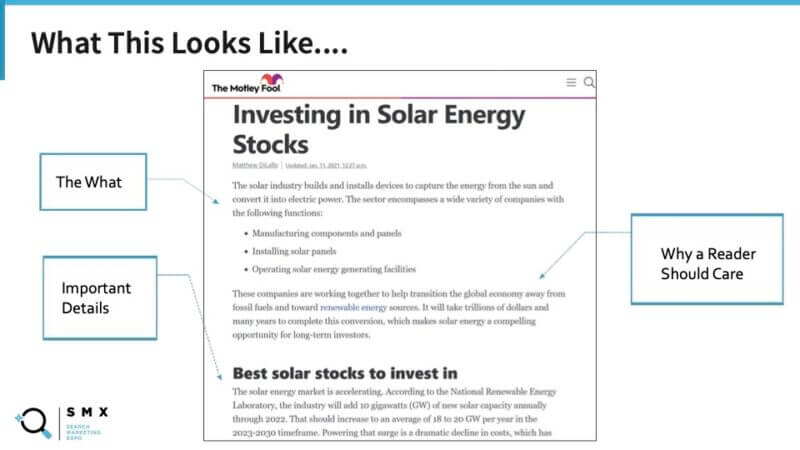
The most important information typically includes answering the 5 Ws (who, what, when, where and why). After that, content creators should address the other important details and supplement with background information. Search Engine Land’s article “Meet Google Analytics 4: Google’s vision for the future of analytics,” is one example of how the inverted pyramid can be applied to content.
It’s important to consider the structure of your content as well. Walls of text can obstruct scanability; “I would consider things like bullet points and a lot of headers [as] a way to break up pages,” Berry said. Engaging visuals serve two purposes here as well: improving scanability by breaking up walls of text while facilitating written content (with additional context or by visualizing data, for example).
Understand E-A-T
Over the last few years, expertise, authoritativeness and trustworthiness (known collectively as E-A-T) have become a well-known concept in the search industry, but for audiences, these concepts have always existed.
“[E-A-T is] super important to incorporate into your content, because . . . from the user perspective, showing off your expertise and your authoritativeness in your space is hugely important,” she said, adding that creating trust signals, for both users and search engines, is also critical.
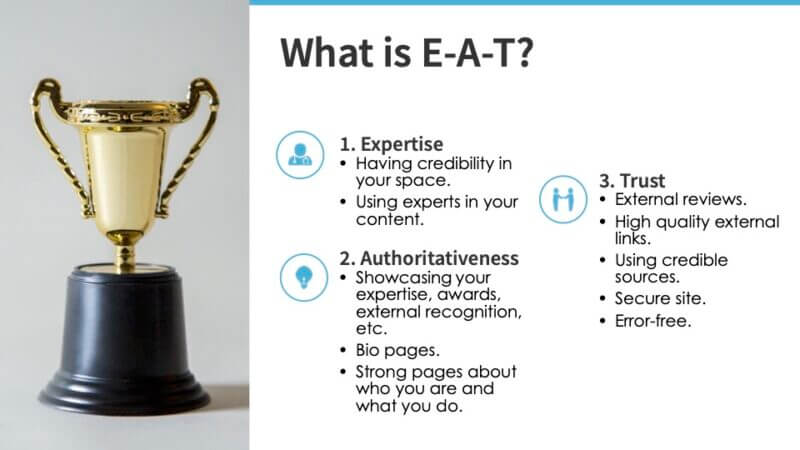
Below are a few ways that Berry recommends brands and publishers demonstrate E-A-T.
Expertise:
- Having credibility in your space.
- Using experts in your content.
Authoritativeness:
- Showcasing your expertise, awards, external recognition, etc.
- Author bio pages.
- Strong pages about “who” your organization is and what it is about.
Trust:
- External reviews.
- High-quality external links.
- Use credible sources.
- Secure your site.
- Ensure your site copy and content are error-free.
Brands and publishers should be familiar with Google’s standards for Your Money or Your Life (YMYL) content. “These are pages or topics that could impact a person’s future happiness, their health, their financial stability or safety,” Berry said, “So, really, these are the most important topics to a person.”
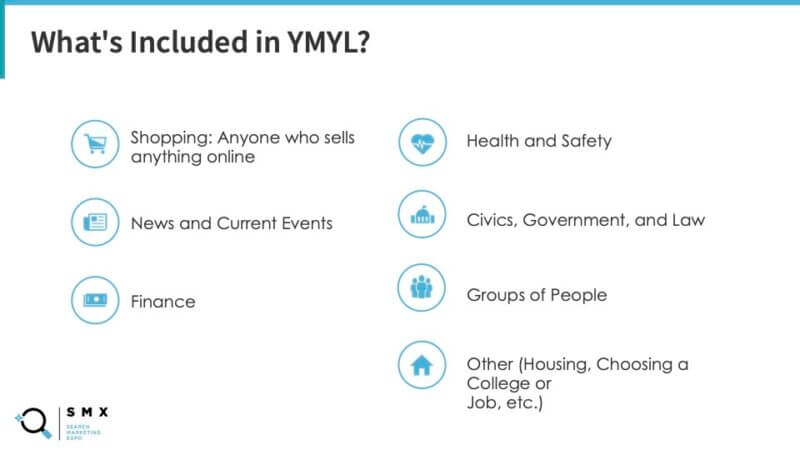
Google holds YMYL content, which includes content about shopping, news and current events, finance, health and safety, civics, government, law, groups of people, housing, education and so on, to a higher standard of E-A-T as incorrect information on these subjects may harm users.
While subject matter experts do have the expertise, they may not be the best content creators. When that’s the case, Berry recommends interviewing them instead of using them as creators.
And, updating your content regularly can ensure that it reflects the latest news or developments. How often publishers should update their content can vary by industry, “But, if you have evergreen pages that are designed to rank for the long term, you need to pay attention to what your competitors are doing and how often the search results are changing,” Berry said, noting that her organization has set up alerts when rankings fall and when content goes 90 days without being updated so that her team can assess whether updates should be made.
Answer the questions your audience is asking
Users come to your site for a reason and addressing that reason can help you increase your search visibility and facilitate conversions. The first step to answering the questions your audience may have is by identifying those questions.
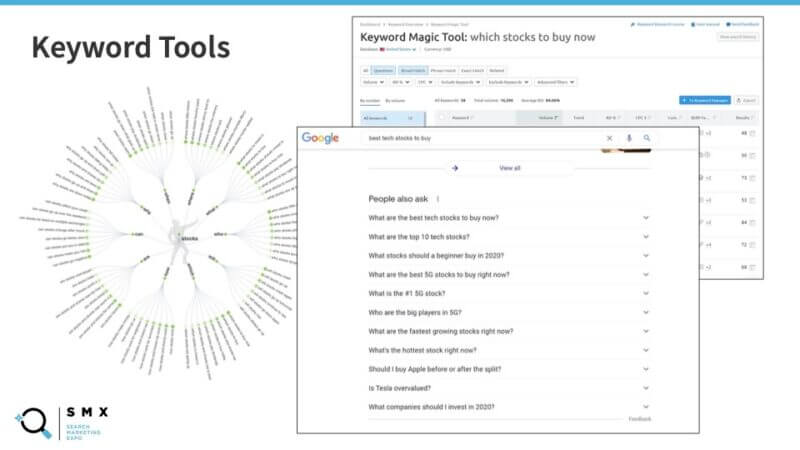
Keyword tools can help figure out what those questions are as well as the opportunity, represented by search volume, that goes with answering each question. In the example above, Berry used Answer the Public in tandem with a keyword tool, which is a common feature among tool providers like Semrush, Ahrefs and Moz, to identify content and keyword ideas and search volume. “Don’t forget about things like People also ask or the bottom of the search results [Related searches] because these can also really help inform what should be on your pages,” she added.
Marketers can also turn to social media and forums (like Reddit or Quora) to see what questions their audience may have. Talking to customers directly, or surveying them, can also help you source content ideas.
Create linkable content
“There are definitely types of content that do better for link building,” Berry said, adding that linkable content must have a unique angle.
Conducting primary or secondary research can help your content amplification efforts as it takes data and turns it into something digestible for journalists (that may link to you in their own articles) as well as your audience. For those in the position to publish primary research, there may be an advantage in that your business owns that data, making it unique to your brand. For example, Spotify uses its own data when it publishes its annual Spotify Wrapped digest.
“Data visualizations and infographics are also hugely compelling, especially if you’re taking something really complicated and making it a lot easier to understand,” Berry said.
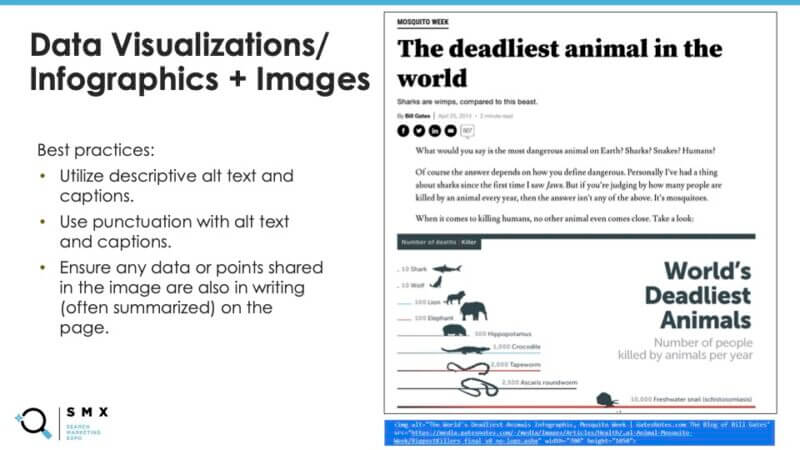
“With data visualizations and infographics and images, you need to utilize alt text and captions and make them very descriptive,” she said, emphasizing that members of your audience may be using assistive technologies to navigate your content. Using the appropriate punctuations within your alt text and captions, and summarizing data that is in your images within the text as well can also greatly improve the user experience: “If you’ve ever watched somebody use assistive technology — [for example] somebody using a screen reader — if you don’t use punctuation . . . it’s really a painful experience because it reads on and on and on. There are no breaks and that can be super overwhelming to somebody who’s listening to the content,” she said.
Content featuring controversial opinions, or “hot takes,” can help generate links as they often provide unique perspectives. “Ego-bait lists,” another tactic that Berry mentioned, can also be used to amplify your content by compiling opinions from experts, or a list of the experts themselves, as is often the case in the search industry.
“Make sure that you’re utilizing the formats that you can really do well, and that are going to give you a competitive edge,” Berry said, “And make sure that, no matter what format you’re using, you’re really following that inverted pyramid and you’re answering your audience’s questions well. Make the content really easy for people to access and understand and scan and you’ll go far.”
Watch the full SMX Next presentation here (free registration required).
https://searchengineland.com/4-elements-that-help-create-compelling-seo-content-377285


